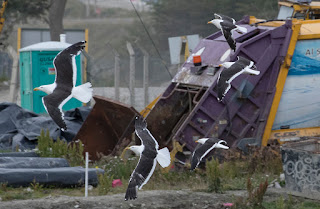Well you'd think after being back seven weeks from a trip I would have more Blog postings from said trip. I did have 8500 photos to sort through. The main excuse for being blogless is not knowing where to start so I'll start with a subject I like. The Gulls. The purpose of the cruise 25 Jan to 6 Feb 2020 from Buenos Aries, Argentina to Santiago, Chile was mainly for the seabirds and an opportunity to see some of the Antarctic. Any gulls were gravy.
Gull diversity was actually low with only five species on the trip. Only Kelp Gull was widespread and common. Dolphin Gull and Brown-hooded Gull were numerous within their range. On the last day of the trip at San Antonio, Chile (near Santiago) there were plenty of wintering Franklin's Gulls and a few of the beautiful Gray Gull. Kelp Gull was the gull of most interest. It is a bird we need to know in Newfoundland. An adult kelp Gull did happen in St. John's 23 & 25 December 2016 [see the posting with pictures here http://brucemactavish1.blogspot.com/2016/. ]It could happen again. First impressions were about Herring Gull size and identical in behavior. Darker black than Great Black-backed Gull. A broad white trailing edge to secondaries while not as obvious as Slaty-backed Gull was still easily noticeable among our local gulls. The legs were greenish, sometimes with a yellowish tinge.
Note those greenish legs. This was typical leg colour of the Kelp Gulls that I saw during the period of observation late Jan/early Feb. Descriptions/photos of Kelp Gull usually say/show the legs are yellowish with a greenish tint. I think this probably true during height of breeding display in spring and early breeding season. I was present at the end of the nesting season. Chicks were large in the nests and in San Antonio, Chile there were many recently fledged juveniles. The St. John's, Newfoundland Kelp Gull had dull greenish legs in late December which should have been height of breeding season for Kelp Gulls in the Southern Hemisphere. However, the St. John's bird was still growing P10 indicating it had adjusted to the Northern Hemisphere seasons and was going into winter plumage. photo: 1 Feb 2020, Ushuaia, Argentina
The dump at Ushuaia, Argentina, Cape Horn is the most southern dump in the world and about ten minutes via taxi from the dock in case you are ever there. Not the first destination for the average traveler. While Richard Crossley and I were there on foot the dump operators and dump dog allowed us in no problem but motioned for us to stand off to the side. No English. Views were pretty good but short of ideal
1 Feb 2020, Ushuaia, Argentina (any gulls with red bills that creep into this Kelp Gull salon are Dolphin Gulls. Their blog posting is coming soon)
1 Feb 2020, Ushuaia, Argentina
1 Feb 2020, Ushuaia, Argentina
Adult and 1st cycle Kelp Gull 1 Feb 2020, Ushuaia, Argentina
1 Feb 2020, Ushuaia, Argentina
1 Feb 2020, Ushuaia, Argentina
1 Feb 2020, Ushuaia, Argentina
1 Feb 2020, Ushuaia, Argentina
1st cycle Kelp Gull. 1 Feb 2020, Ushuaia, Argentina
1 Feb 2020, Ushuaia, Argentina
1 Feb 2020, Ushuaia, Argentina
1 Feb 2020, Ushuaia, Argentina
1 Feb 2020, Ushuaia, Argentina
1 Feb 2020, Ushuaia, Argentina
1 Feb 2020, Ushuaia, Argentina
1 Feb 2020, Ushuaia, Argentina
1 Feb 2020, Ushuaia, Argentina
1 Feb 2020, Ushuaia, Argentina
1 Feb 2020, Ushuaia, Argentina
1 Feb 2020, Ushuaia, Argentina
1 Feb 2020, Ushuaia, Argentina
1st cycle Kelp Gull - 1 Feb 2020, Ushuaia, Argentina
A picture of adult Kelp Gulls resting on a glaciers on the Antarctic Peninsula, on 29 Jan 2020.
Punta Arenas, Chile on 2 Feb 2020
The following pictures are all from Punta Arenas Chile in the southern tip of the country (not far from Ushuaia, Argentina!).
The colour of those Feet!! Stamp of approval for Kelp Gull.
The reddish orbital ring and shaded olive-coloured iris were typical of the Kelp Gulls at this southern latitude.
The feet and legs were looking more yellowish on the bird above and below that were only 50 m apart but did not seem to be a pair.
This bird was one of maybe two I saw with a mirror on P9. it was in fact photographed on The Falkland Island on 25 Jan 2020.
I have a few juvenile Kelp Gull photos from San Antonio, Chile that I was going to add to this post but I seem to have met the limit for number of photos. The end of the day update on C-19 makes me wonder when the next time mankind will even care about the identification of Kelp Gull.
Birders will carry on after the crumbling of civilization as we know it now. The genes have been sown.
B Mactavish, (19:00) 29 March 2020, St. John's, Newfoundland.





































No comments:
Post a Comment
Note: only a member of this blog may post a comment.